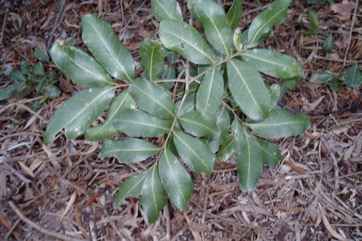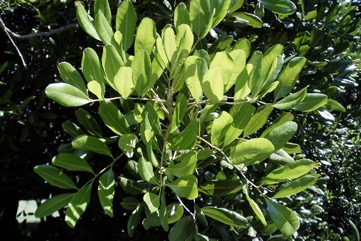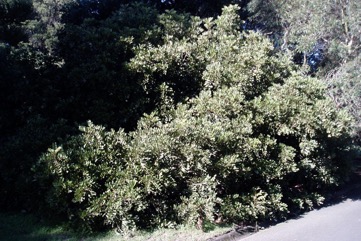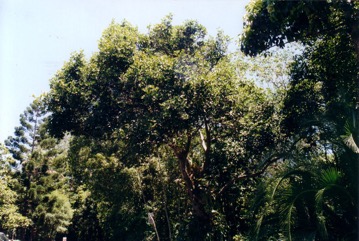Tuckeroo, Beach Tamarind, Carrotwood

It grows in warm temperate to tropical places. It is native to Australia. In tropical Queensland it grows from sea level to 800 m altitude. It needs good drainage. It can grow in dry soil. It can grow in full sun or light shade. It can grow in coastal regions. It can tolerate salt. It is damaged by frost. It suits hardiness zones 9-11. Melbourne Botanical Gardens. Arboretum Tasmania.
Also known as:
Bulkul
Synonyms
- Alectryon bleeseri O. Schwarz
- Cupania anacardioides A. Rich.
Edible Portion
- Fruit
Where does Tuckeroo grow?
Found in: Asia, Australia, Hawaii, India, Pacific, North America, Pakistan, Tasmania, United States
Notes: There are 60 Cupaniopsis species. It can be invasive.
Growing Tuckeroo, Beach Tamarind, Carrotwood
Cultivation: Plants can be grown from fresh seed. Seed should be soaked before planting. It can take one month for seed to germinate. It should be grown vegetatively from good fruiting trees. This can be done by layering.
Edible Uses: The ripe orange fruit are eaten. It is the fleshy aril or layer around the seeds that is eaten.
Production: It is a slow growing tree.
Nutrition Info
per 100g edible portion| Edible Part | Energy (kcal) | Protein (g) | Iron (mg) | Vitamin A (ug) | Vitamin c (mg) | Zinc (mg) | % Water |
|---|---|---|---|---|---|---|---|
| - | - | - | - | - | - |
Tuckeroo, Beach Tamarind, Carrotwood Photos




References
Anon., 2003, Native Plants for the Fitzroy basin. Society for Growing Australian Plants Inc. (Rockhampton Branch)
Bodkin, F., 1991, Encyclopedia Botanica. Cornstalk publishing, p 306
Calvert, G., 2010, The Burdekin Delta Tree Guide. Lower Burdekin Landcare Association., Inc., Ayr p 65
Cooper, W. and Cooper, W., 2004, Fruits of the Australian Tropical Rainforest. Nokomis Editions, Victoria, Australia. p 481
Cronin, L., 1989, The Concise Australian Flora. Reed. p 173
Cundall, P., (ed.), 2004, Gardening Australia: flora: the gardener's bible. ABC Books. p 443
J. S. C. Dumont d'Urville, Voy. Astrolabe 2:33, t. 13. 1834 (Sert. Astrolab.)
Etherington, K., & Imwold, D., (Eds), 2001, Botanica's Trees & Shrubs. The illustrated A-Z of over 8500 trees and shrubs. Random House, Australia. p 244
Haslam, S., 2004, Noosa's Native Plants. Noosa Integrated Catchment Assn. Inc. p 22
Heywood, V.H., Brummitt, R.K., Culham, A., and Seberg, O., 2007, Flowering Plant Families of the World. Royal Botanical Gardens, Kew. p 294
Hibbert, M., 2002, The Aussie Plant Finder 2002, Florilegium. p 77
Holliday, I., 1989, A Field Guide to Australian Trees. Hamlyn. p 116
Jackes, B.R., 2001, Plants of the Tropics. Rainforest to Heath. An Identification Guide. James Cook University. p 80
Krishen P., 2006, Trees of Delhi, A Field Guide. DK Books. p 247
Leiper, G & Houser, J., Mutooroo. Plant Use by Australian Aboriginal People. Assembly press, Queensland.
Lord, E.E., & Willis, J.H., 1999, Shrubs and Trees for Australian gardens. Lothian. p 14
Marinelli, J. (Ed), 2004, Plant. DK. p 451
Melzer, R. & Plumb, J., 2011, Plants of Capricornia. Belgamba, Rockhampton. p 325
Molyneux, B & Forrester, S., 1997, The Austraflora A-Z of Australian Plants. Reed. p 71
Nicholson, N & H., 1996, Australian Rainforest Plants, Terania Rainforest Publishing. NSW. p 23
Paczkowska, G . & Chapman, A.R., 2000, The Western Australian Flora. A Descriptive Catalogue. Western Australian Herbarium. p 528
Pearson, S. & A., 1992, Rainforest Plants of Eastern Australia. Kangaroo Press p 74
Staples, G.W. and Herbst, D.R., 2005, A tropical Garden Flora. Bishop Museum Press, Honolulu, Hawaii. p 517
Townsend, K., 1994, Across the Top. Gardening with Australian Plants in the tropics. Society for Growing Australian Plants, Townsville Branch Inc. p 149
Townsend, K., 1999, Field Guide to Plants of the Dry Tropics. Society for Growing Australian Plants, Townsville Branch Inc. p 41
Williams, J.B., Harden, G.J., and McDonald, W.J.F., 1984, Trees and shrubs in rainforests of New South Wales and Southern Queensland. Univ. of New England, Armidale. p 43